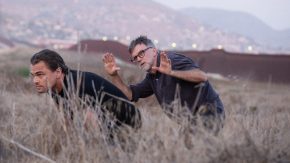If we could travel in time, I would gladly have a few cup of coffees with the Master who – as we can know from Ádám Bősze’s presentations – always ordered his staff, in times when he had it, to take sixty coffee beans to make his drink. He wasn’t an easy person, also revealed by the rotating number of household maids and butlers.
In the #Beethoven250Challenge, a video series started by Müpa, we can spend our five-minute coffee breaks with the composer who was born 250 years ago. If we check out the videos uploaded on the Müpa Youtube channel or the Facebook site, we will feel to be a close acquaintance of Beethoven, sometimes called ‘the Spanish’ because of his looks.
Most of the recordings are from his early years, which experts consider as the time of stretching out of known forms and writing self-expressive, revealing pieces. Then we arrive to Eroica, a turning point in the history of music, then to Fidelio, which he started to write in the early phase but only became successful in the more mature, later part of his career. This was also typical: he often rewrote his works and let them develop over a longer timespan. But now let’s see the recordings and coffees one by one!
Sonata for cello and piano in G minor; op. 5, part 2.
This is a light introduction if we are only getting to know Beethoven. The recording is a great choice because it emphasises the equivalent play of the cellist and the pianist, and it also provides interesting information on the instruments. We recommend a short espresso to this enchanting and playful music.
Piano Concerto No. 3 in C minor; op. 37.
In this music that appeals to our souls, soft melodies bring us closer to Beethoven’s musical world. This recording is a living testimony of him breaking the rules and creating new things. The Master was always sceptical towards harmonics, and one time he wrote Du Esel (You Idiot) in his notebook, referring to an expert who had created musical rules. Beethoven also worked on a detailed refutation of his regulations. At the Spring Festival, we can find out a bit of the secrets of the thirds. We need some irregular type of coffee to that, like Espresso Romano, the one with the lemon peel spiral.
String Quartet No. 6 in B-flat major; op. 18, No. 6
We can hear this work by the Wiener Kammerensemble, and the subtitles also reveal that in Beethoven’s age, women weren’t entitled to play string instruments; that was considered indecent. Fortunately this has changed, but this information can bring us to reflect on the componist’s relationship to ladies, a debated issue even today. The music is a great accompaniment to that, being tender and soft, so I recommend a milky coffee to that, the Viennese Melange.
Septet in E-flat major; op. 20.
No matter how hard our day was, this recording will make us smile. This not-so-usual setting of three aerophones and four string instruments creates a true joyful music, sometimes smiling and sometimes even winking at each other. Subtitles tell us that what we hear here was the pop music of Beethoven’s era, and we don’t even have a hard time imagining a circle of friends of that time, chatting while listening to this piece. Let’s drink a light coffee to that, like a Latte Macchiato!
The Creatures of Prometheus
This recording was a great discovery for me, a real pearl in Beethoven’s life work, his ballet music. Its twisting, vibrant melodies take us with them – we are waiting for the dancers to appear and the story of Prometheus to unfold. We can feel, not only from the subtitles but also from the sound, that Beethoven’s music was influenced by the French Revolution and the Enlightenment ideologies. Maybe this is why this music can sound so rousing, even bringing the composer’s name overseas. I would drink a cappuccino to this, with some light foam on the top.
Moonlight Sonata
An indescribably wonderful music played by Tamás Vásáry. At one point we could read that a crater on the planet Mercury bears Beethoven’s name, and here we can really feel as if we have been invited to an interstellar journey by the composer. One can also see that Vásáry is also totally taken by the beauty of the music. I recommend an Irish coffee, the one with the many ingredients, because it fits to the complexity of this piece.
Romance for violin and orchestra No. 1 in G major; op. 40
Pinchas Zukerman not only plays but also conducts the members of Camerata Salzburg around him. This recording shows clearly how one can lead a group without conducting with a stick. Zukerman uses all his cells in this huge work, all instruments sound equally, playing this early piece of the Master as a great ensemble. I think I would ask the barista of the imaginary musical coffee shop to bring me a Con Panna with some whipped cream on it to this music.
Symphony No. 2 in D major; op. 36
I like Gábor Hollerung’s conducting style anyway, but I have watched this recording over and over again because it shows his playfulness very nicely. The subtitle states that this is one of the most cheerful of Beethoven’s pieces, and the many harmonies give a hard job to the musicians. It is intriguing that this is where the so-called Heiligenstadt testimony is mentioned, which is a letter written by Beethoven to his siblings, telling them about his deafness. The composer didn’t break down even with his ever-worsening state, and this piece radiates pure optimism. Because this is such a sunny, summerish work, I would most gladly drink a frappé to it!
Symphony No. 3 (Eroica) in E flat major; op. 55.
The Savaria Orchestra, conducted by Gergely Madaras, brings the rebellious Beethoven to us who deleted the original title after hearing that Napoleon, the original inspiration for the piece, declared himself to be emperor. This work also had an ambivalent reception in its time. The music is full with complex harmonies and has an immersively poetic style, which is also a turning point in the history of music. I guess a dramatic, clean Doppio would fit to it well.
Fidelio
This Müpa show, basis of this recording, is an unforgettable experience. Beethoven gave a hard job not only for instrumentalists but also singers, and I appreciated Tünde Leonóra Szabóki (Fidelio) very much, the one who appears in this recording once again. At the time this piece was written, the figure of a strong woman who enters all dangers to help his imprisoned husband was a new phenomenon, which brings a lot of challenges for the cast, both in singing and playing the role. If you only have time to watch one video, this should be the one, accompanied by a characteristic Ristretto.
The video series by the Müpa shows how multicoloured Beethoven was, and we can also learn a lot of new things about the composer within a relatively short amount of time. If we want to have five minutes of relaxation during our busy workdays, we should definitely turn on the playlist called #Beethoven250Challenge.
Article: Anna Rácz
Translation: Zsófia Hacsek

























Comments